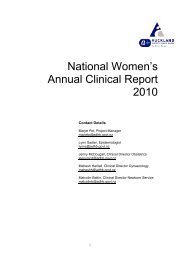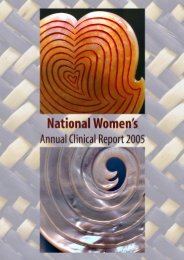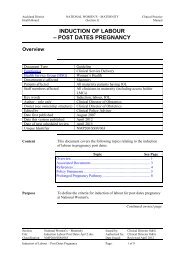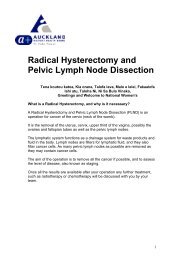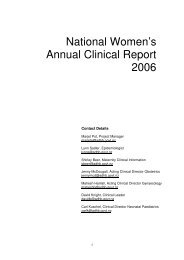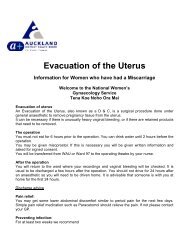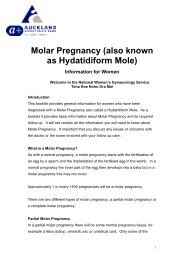Hypertension - National Women's Hospital - Auckland District Health ...
Hypertension - National Women's Hospital - Auckland District Health ...
Hypertension - National Women's Hospital - Auckland District Health ...
You also want an ePaper? Increase the reach of your titles
YUMPU automatically turns print PDFs into web optimized ePapers that Google loves.
If printed, this document is only valid for the day of printing.<br />
<strong>Hypertension</strong> – Antenatal, Intrapartum and Postpartum<br />
Document Type Guideline<br />
Function(s) Clinical Service Delivery<br />
<strong>Health</strong> Service Group (HSG) Women’s <strong>Health</strong><br />
Department(s) affected Maternity<br />
Patients affected (if applicable) All patients in Maternity<br />
Staff members affected All clinicians in Maternity<br />
Key words <strong>Hypertension</strong>, pre eclampsia,<br />
Author – role only Maternal Fetal Medicine (MFM) consultant<br />
Owner (see ownership structure) Clinical Director of Obstetrics, Women’s <strong>Health</strong><br />
Edited by Clinical Policy Advisor<br />
Date first published May 2009<br />
Date this version published March 2012<br />
Date of next scheduled review March 2015<br />
Unique Identifier NMP200/SSM/074<br />
Contents<br />
1. Purpose of guideline<br />
2. Guideline management principles and goals<br />
3. Definitions<br />
4. Summary table<br />
5. Pre-pregnancy care<br />
a) Management of chronic hypertension<br />
b) Prevention and prediction of pre-eclampsia<br />
6. General antenatal care<br />
7. Antenatal management of chronic hypertension<br />
8. Antenatal monitoring in pre-eclampsia<br />
9. Antenatal therapy in pre-eclampsia and hypertension<br />
10. Management in labour<br />
11. Severe pre-eclampsia<br />
12. Acute management of hypertension<br />
13. Anaesthesia and analgesia for women with pre-eclampsia and hypertension<br />
14. Criteria for transfer to critical care<br />
15. Postpartum management<br />
16. What to do before developing an antenatal care plan<br />
17. What to do after the risk assessment<br />
18. Supporting evidence<br />
19. Associated ADHB documents<br />
20. Disclaimer<br />
21. Corrections and amendments<br />
<strong>Hypertension</strong> - Antenatal Intra- & Postpartum Mar12.doc<br />
Page 1 of 24
If printed, this document is only valid for the day of printing.<br />
1. Purpose of guideline<br />
This guideline describes evidence based care for women with background<br />
hypertension and pre-eclampsia for clinicians within <strong>Auckland</strong> <strong>District</strong> <strong>Health</strong> Board<br />
(ADHB).<br />
Back to Contents<br />
2. Guideline management principles and goals<br />
Pre-eclampsia complicates 2 - 3% of all pregnancies (5 - 7% of nulliparous women)<br />
and 2% of women with pre-eclampsia develop eclampsia. A priority of antenatal care in<br />
the second half of pregnancy is to detect the development of pre-eclampsia. When<br />
pre-eclampsia develops, delivery of the baby and placenta is the only cure.<br />
Management is aimed at timing delivery to prevent maternal complications whilst<br />
minimising fetal morbidity and mortality from prematurity and associated intrauterine<br />
growth restriction.<br />
Back to Contents<br />
3. Definitions<br />
SBP = systolic blood pressure<br />
DBP = diastolic blood pressure<br />
PCR = protein creatinine ratio<br />
MFM = maternal fetal medicine<br />
<strong>Hypertension</strong> is a blood pressure SBP ≥ 140 and/or DBP ≥ 90 mmHg on two or more<br />
consecutive occasions at least 4 hours apart or one measurement SBP ≥ 170 and or<br />
DBP ≥ 110 mmHg.<br />
Women with an increment of > = 30 mmHg systolic and/or > = 15 mmHg diastolic but<br />
not at the levels above do not meet the definition of hypertension, however, such<br />
women should be monitored more closely.<br />
Severe hypertension is a SBP ≥ 170 and or DBP ≥110 mmHg on one occasion at any<br />
time.<br />
Proteinuria for definition of pre-eclampsia is a PCR ≥ 30 on a spot urine sample, ≥ 2+<br />
on two separate dipstick measures or a 24 hour collection ≥ 0.3g in 24 hours. Because<br />
of the close correlation between spot urine PCR and 24 hour urine, the latter is rarely<br />
required (SOMANZ). Repeated quantitative estimations of proteinuria may be of value<br />
in assessing disease progression however neither the rate of increase nor the amount<br />
of proteinuria affects maternal or perinatal outcome.<br />
Pre-eclampsia is when hypertension arises after 20 weeks gestation and is<br />
accompanied by one of more of the following: (SOMANZ)<br />
<strong>Hypertension</strong> - Antenatal Intra- & Postpartum Mar12.doc<br />
Page 2 of 24
If printed, this document is only valid for the day of printing.<br />
Renal involvement:<br />
Significant proteinuria – dipstick proteinuria subsequently confirmed by spot<br />
urine protein/creatinine ratio ≥ 30mg/mmol. In view of the close correlation<br />
between spot urine protein/creatinine ratio and 24 hour urine excretion, the latter<br />
is rarely required (21)<br />
Serum or plasma creatinine > 90 μmol/L<br />
Oliguria<br />
Haematological involvement:<br />
Thrombocytopenia<br />
Haemolysis<br />
Disseminated intravascular coagulation<br />
Liver involvement:<br />
Raised serum transaminases<br />
Severe epigastric or right upper quadrant pain<br />
Neurological involvement:<br />
Also:<br />
Convulsions (eclampsia)<br />
Hypereflexia with sustained clonus<br />
Severe headache<br />
Persistent visual disturbances (photopsia, scotomata, cortical blindness, retinal<br />
vasospasm)<br />
Stroke<br />
Pulmonary oedema<br />
Fetal growth restriction<br />
Placental abruption<br />
<strong>Hypertension</strong> - Antenatal Intra- & Postpartum Mar12.doc<br />
Back to Contents<br />
Page 3 of 24
If printed, this document is only valid for the day of printing.<br />
4. Summary table<br />
Problem Recommended Action<br />
Background<br />
<strong>Hypertension</strong><br />
or Previous<br />
PET<br />
Antenatal<br />
<strong>Hypertension</strong><br />
<strong>Hypertension</strong><br />
in Labour<br />
Eclampsia<br />
Post Natal<br />
<strong>Hypertension</strong><br />
<strong>Hypertension</strong> - Antenatal Intra- & Postpartum Mar12.doc<br />
Review cause and effect<br />
Refer MFM if severe HT or previous early onset<br />
preeclampsia ≤ 30 weeks<br />
Consider prophylaxis with Aspirin/Calcium<br />
Coordinate more frequent antenatal reviews<br />
Regular fetal growth assessment (monthly if uncomplicated,<br />
more frequently if additional clinical concerns)<br />
Review cause and effect<br />
Consider treatment if SBP ≥ 140 - 160 and or DBP ≥ 95 -<br />
100 consistently<br />
Discuss case with obstetric senior clinical staff member<br />
(obstetrician +/- Physician) and MFM as appropriate<br />
(especially if ≤ 30 weeks)<br />
Review cause and effect<br />
Consider treatment if SBP ≥ 160 and or DBP ≥ 100 or if<br />
symptomatic in women with previously lower booking blood<br />
pressure<br />
See <strong>Hypertension</strong> in Labour – Management for<br />
recommended medications<br />
Consider use of epidural<br />
Consider use of magnesium sulphate (see ‘Associated<br />
ADHB documents’ section below for guideline)<br />
Discuss with obstetric senior clinical staff member<br />
(obstetrician +/- Physician) and MFM as appropriate<br />
(especially if ≤ 30 weeks)<br />
Use ABC for immediate resuscitation<br />
See ‘Associate ADHB documents’ section below for<br />
magnesium sulphate guideline<br />
Seek advice, support and High Dependency Unit (HDU)<br />
care (see below)<br />
Recommended total fluid rate = 85mls/hour<br />
Review cause and effect<br />
Consider treatment if SBP > 160 and or DBP > 100<br />
consistently<br />
Definitely treat if SBP > 170, DBP > 110 consistently<br />
Consider magnesium sulphate especially within 48 hours of<br />
delivery (see ‘Associated ADHB documents’ section below<br />
for guideline)<br />
Discuss case with senior clinical staff member and MFM if<br />
additional concerns<br />
Back to Contents<br />
Page 4 of 24
If printed, this document is only valid for the day of printing.<br />
5. Pre-pregnancy care<br />
<strong>Hypertension</strong> arising before pregnancy or detected in the first 20 weeks of pregnancy<br />
implies long-standing or chronic hypertension. The majority of these women have<br />
essential hypertension with no underlying renal or adrenal cause however should be<br />
referred for medical opinion early in pregnancy. Very rarely pre-eclampsia may present<br />
before 20 weeks often in the context of an abnormal foetus/baby or severe maternal<br />
disease and usually with abnormal indices of utero placental circulation.<br />
a) Management of chronic hypertension<br />
<strong>Hypertension</strong> - Antenatal Intra- & Postpartum Mar12.doc<br />
Back to Contents<br />
Other causes of chronic hypertension should always be considered e.g. renal<br />
disease, phaeochromocytoma, Cushing’s syndrome, Conn’s syndrome, coarctation<br />
of aorta.<br />
<strong>Hypertension</strong> should ideally be controlled before conception. Specific consideration<br />
should be given to the choice of anti-hypertensive in women who may become<br />
pregnant. For those women with complicated pre-existing hypertension (including<br />
those on more than one antihypertensive agent) we would recommend<br />
preconception referral for obstetric physician review and discussion. Currently it<br />
seems reasonable to continue ACE inhibitors before pregnancy especially in<br />
women with specific indications (i.e. diabetic nephropathy) but with specific<br />
instructions to stop these as soon as pregnancy is suspected and to then attend for<br />
medical review.<br />
Methyldopa remains the first drug of choice for the longer term treatment in<br />
pregnancy. Alternatives (listed in order of published data including safety data;<br />
most extensive data first) include labetalol, slow-release nifedipine, and metoprolol.<br />
ACE inhibitors, diuretics and atenolol should be avoided due to potential fetal side<br />
effects (see Antenatal Management of Chronic <strong>Hypertension</strong>).<br />
Back to Contents<br />
Page 5 of 24
If printed, this document is only valid for the day of printing.<br />
b) Prevention and prediction of pre-eclampsia<br />
Prediction<br />
Currently pre-eclampsia cannot be reliably predicted or prevented although various<br />
risk factors have been identified which may be present at antenatal booking<br />
(SOMANZ).<br />
Risk Factor Relative risk [95% CI]<br />
Previous history of pre-eclampsia 7.19 [5.85,8.83]<br />
Antiphospholipid antibodies 9.72 [4.34,21.75]<br />
Pre-existing diabetes 3.56 [2.54,4.99]<br />
Multiple pregnancy 2.91 [2.04, 4.21]<br />
Nulliparity 2.91 [1.28, 6.61]<br />
Family history of pre-eclampsia 2.90 [1.70, 4.93]<br />
Elevated BMI > 25 2.47 [1.66, 3.67]<br />
Maternal age ≥ 40 1.96 [1.34, 2.87]<br />
Diastolic BP ≥ 80 mmHg at booking 1.38 [1.01, 1.87]<br />
A number of other factors are also associated with an increased risk of<br />
preeclampsia including chronic hypertension, pre-existing renal disease,<br />
autoimmune disease, > 10 years since previous pregnancy, short sexual<br />
relationship prior to conception, other thrombophilias e.g. Factor V Leiden and<br />
possibly periodontal disease.<br />
Low dose aspirin (LDA)<br />
LDA (100mg daily) initiated early in pregnancy reduces the overall risk of preeclampsia<br />
by about 15% with a similar reduction in perinatal death. Prophylactic<br />
use in pregnancy should be considered in women with an increased risk of preeclampsia<br />
as above.<br />
Calcium<br />
Women with low calcium intake (< 600mg/day or ≤ 2 portions or cups of calcium<br />
rich foods) should be offered prophylaxis with calcium supplements of 1 – 1.5 g<br />
daily of elemental calcium (calcium carbonate 1.25 g contains 500mg of elemental<br />
calcium) as this reduces the risk of preeclampsia by about 60% {RR 0.36 (0.18 -<br />
0.70)]. Calcium rich foods are mainly diary products including: yoghurt (not low fat),<br />
milk (any fat and including flavoured milk), and cheese (25g = 200mg calcium).<br />
Calcium in smaller amounts is also available in deep green leafy vegetable, fish<br />
with edible bones, tofu made with calcium, legumes and foods fortified with calcium<br />
(Villar 2006). Women at very high risk of preeclampsia also benefit from calcium<br />
supplement [RR 0.22 (0.12 - 0.47)]. The doses above refer to elemental calcium<br />
(Cochrane library).<br />
<strong>Hypertension</strong> - Antenatal Intra- & Postpartum Mar12.doc<br />
Page 6 of 24
If printed, this document is only valid for the day of printing.<br />
Low dose pregnancy multivitamin/folic acid<br />
Preliminary evidence suggests that low dose pregnancy multivitamins containing<br />
folic acid may also reduce the risk of preeclampsia (Wen 2008, Bodnar 2006). Note<br />
high dose vitamin C and vitamin E are not of benefit in reducing preeclampsia and<br />
may be harmful (Poston, 2006).<br />
Antenatal visits<br />
The frequency of antenatal visits to check blood pressure and urine should be<br />
increased in women with two or more risk factors (PRECOG). These women may<br />
be eligible to visit the Day Assessment Unit (DAU) rather then be admitted to the<br />
antenatal or other ward.<br />
Admission - Day Assessment Unit: please see the Associated ADHB document<br />
section below.<br />
Severe or atypical disease<br />
For advice on the management of women with a history of particularly severe or<br />
atypical disease contact the MFM consultant or an obstetric physician. Women with<br />
a past history of severe pre-eclampsia (complicated or leading to delivery before 32<br />
weeks) should be referred to MFM consultant care in the first trimester and have at<br />
least fortnightly BP and urine checks after 20 weeks. The APEC leaflet is a useful<br />
resource of information for these women.<br />
Back to Contents<br />
6. General antenatal care<br />
Patient information<br />
Each woman should be informed verbally by her lead maternity carer (LMC) at booking<br />
and given written information about the symptoms and signs of pre-eclampsia and the<br />
reasons why BP and urine are checked at each visit (APEC leaflet).<br />
Maternal Fetal Medicine Referral – please see Associated ADHB document section<br />
below.<br />
Taking the blood pressure (ASSHP, SOMANZ)<br />
i Use a mercury sphygmomanometer;<br />
ii Use the correct cuff - if the arm circumference > 33 cm use a large cuff;<br />
iii Keep the cuff at the level of heart;<br />
iv Use a seated position with feet supported;<br />
v By convention the right arm is usually used to reduce observer error;<br />
vi Record the exact reading i.e. 128/88, not 130/90;<br />
vii Deflate the cuff slowly at approximately 2 mmHg per second;<br />
viii Use Korotkoff 5 or K5 (disappearance of sounds) not K4 (muffling), unless sounds<br />
are heard to zero when K4 should be used;<br />
<strong>Hypertension</strong> - Antenatal Intra- & Postpartum Mar12.doc<br />
Page 7 of 24
If printed, this document is only valid for the day of printing.<br />
ix Automated blood pressure monitors can significantly underestimate the blood<br />
pressure in pre-eclampsia. It is recommended that automated blood pressure<br />
values should be compared with conventional sphygmomanometery at admission<br />
or at the beginning of treatment.<br />
Day Assessment Unit (DAU)<br />
Referral to the DAU for further assessment and investigation should be considered<br />
when there is a suspected hypertensive disorder of pregnancy, and there is a need for<br />
visits outside the weekly clinic setting. DAU is open 5 days a week and is established<br />
for women to improve continuity of care, improve psychological well being, reduce<br />
disruption to family life and reduce inpatient stays. This model of care has been proven<br />
to be successful and safe and may improve outcomes for the women. When referring<br />
to DAU please use the referral form in the clinical areas and ensure a member of the<br />
clinical team has been identified who is contactable and will be responsible for the care<br />
on DAU.<br />
Admission - Day Assessment Unit: please see the Associated ADHB document section<br />
below.<br />
Inpatient admission<br />
Criteria for recommending inpatient admission for assessment include:<br />
Symptoms egg headaches, visual disturbance or epigastric pain<br />
Proteinuria ≥ 1+ with hypertension<br />
SBP ≥ 160 and or DBP > 100<br />
Abnormal blood results: falling or low platelets < 150, rising urate, raised creatinine<br />
(abnormal if > 80µmol/L), raised ALT, AST (abnormal if > 40iu) or raised bilirubin<br />
(abnormal if >)<br />
Antepartum haemorrhage<br />
Reduced fetal movements<br />
Uterine activity<br />
Outpatient care<br />
In later pregnancy women with hypertension in the absence of proteinuria (gestational<br />
hypertension or pregnancy induced hypertension) and with normal blood tests or<br />
uncomplicated pre-eclampsia without symptoms may be managed on an outpatient<br />
basis. This should be coordinated by a consistent senior medical team member.<br />
Careful surveillance for the development of pre-eclampsia or complications (including<br />
fetal) should continue as the development of these substantially increases the risks to<br />
mother and baby. This usually entails 2 or 3 clinical assessments per week. We<br />
recommend that where outpatient review is considered that this should occur in clinic<br />
or the day assessment unit as appropriate (See also details in DAU). Delivery should<br />
be in a secondary or tertiary unit.<br />
<strong>Hypertension</strong> - Antenatal Intra- & Postpartum Mar12.doc<br />
Page 8 of 24
If printed, this document is only valid for the day of printing.<br />
All women managed as an outpatient should be told and understand the symptoms<br />
and signs of concern. Outpatient management of uncomplicated disease does not alter<br />
the clinical outcome but improves the satisfaction with shorter inpatient stays.<br />
Fulminating pre-eclampsia<br />
Women with fulminating pre-eclampsia (usually with severe hypertension (SBP > 170<br />
and or DBP > 110) with or without symptoms) require urgent admission to hospital,<br />
accompanied by a doctor or midwife. It is important to discuss the admission with the<br />
on call labour ward specialist/SMO and on call MFM team.<br />
Bed rest<br />
For mild hypertension in pregnancy in a home or hospital setting has not been shown<br />
to be beneficial and may be harmful, potentially increasing the risk of venous<br />
thromboembolism.<br />
Back to Contents<br />
<strong>Hypertension</strong> - Antenatal Intra- & Postpartum Mar12.doc<br />
Page 9 of 24
If printed, this document is only valid for the day of printing.<br />
7. Antenatal management of chronic hypertension<br />
Normal BP profile in pregnancy<br />
BP decreases in normal pregnancy, reaching its lowest at 20 weeks before rising to<br />
pre-pregnant levels or slightly higher at term. Similar changes are often seen in chronic<br />
hypertension and therefore anti-hypertensive therapy may need to be reduced or<br />
discontinued in early pregnancy.<br />
Threshold for treatment<br />
Anti-hypertensive therapy for mild chronic hypertension decreases the incidence of<br />
severe hypertension but the impact on perinatal outcome is unclear. There is<br />
insufficient evidence on which to base recommendations regarding thresholds for<br />
treatment. Anti-hypertensive drugs may be initiated or increased when the BP is<br />
consistently above SBP ≥ 140 - 160 and or DBP ≥ 95 - 100. Treatment targets should<br />
be individualized but in general we would recommend SBP 140 - 160 and DBP 90 -<br />
100.<br />
Medications<br />
If conception occurs on ACE inhibitors, diuretics or atenolol, anti-hypertensive therapy<br />
should be changed or stopped if not required as soon as possible. We recommend a<br />
preparation with a better safety history in pregnancy (usually methyldopa) (see<br />
Antenatal Therapy in Pre-Eclampsia & <strong>Hypertension</strong>). Discussion with MFM/obstetric<br />
physician including consideration of a MFM clinic review is usually indicated.<br />
Super-imposed pre-eclampsia<br />
Women with chronic hypertension are at increased risk of super-imposed preeclampsia<br />
and require careful assessment if there is an apparent rise in BP or the<br />
development of proteinuria.<br />
Back to Contents<br />
<strong>Hypertension</strong> - Antenatal Intra- & Postpartum Mar12.doc<br />
Page 10 of 24
If printed, this document is only valid for the day of printing.<br />
8. Antenatal monitoring in pre-eclampsia<br />
Several points are worth emphasising:<br />
Severe PET and eclampsia are life-threatening conditions; the labour and birthing<br />
suite (L&B) registrar on call should always inform and involve the on call SMO (+/-<br />
obstetric physician) and the anaesthetist. A plan of management should be made<br />
and written in the patient’s clinical record. The duty paediatrician should also be<br />
informed if preterm delivery is expected<br />
Pre-eclampsia is a multisystem disease, where each end-organ (e.g. blood vessels,<br />
kidney, CNS, liver, clotting system and placenta) may be affected to a greater or<br />
lesser extent. Careful assessment of each end organ is essential for optimal<br />
management<br />
Pre-eclampsia progresses at different rates in different cases; occasionally the rate<br />
of progress can be remarkably rapid. Eclampsia rarely occurs without premonitory<br />
symptoms (e.g. severe headache, visual disturbance, epigastric pain) and<br />
symptoms should always be taken seriously<br />
<strong>Hypertension</strong> is a treatable manifestation of pre-eclampsia. Reducing high blood<br />
pressure will not alter the underlying progression of the disease although in the<br />
short term it may reduce the risk of eclampsia and a cerebrovascular accident<br />
The L&B registrar on call must be informed if any woman has SBP ≥ 170 and or<br />
DBP ≥ 110, which has not fallen below these levels on rechecking 20 minutes later<br />
The registrar on call will be responsible for instituting appropriate antihypertensive<br />
treatment, with supervision from the relevant SMO. (See Acute Management of<br />
<strong>Hypertension</strong> below)<br />
Women whose condition is difficult to control, or who may have renal or hepatic<br />
involvement should be discussed urgently with the relevant SMO an MFM/obstetric<br />
physician on call for delivery unit<br />
40% of eclamptic seizures occur after delivery thus, post-natal vigilance is<br />
essential, although the disease will resolve spontaneously in all but a few cases<br />
Remember ECLAMPSIA can occasionally occur in the absence of hypertension or<br />
proteinuria.<br />
Assessment, physical signs and monitoring<br />
These should be documented in the patient’s clinical record. The development of<br />
hepatic tenderness, hyperreflexia clonus, breathing difficulties, abdominal pain,<br />
antepartum haemorrhage or altered fetal movements are an indication for urgent<br />
senior review.<br />
Daily assessment of maternal and fetal condition is required at registrar level or above<br />
to determine that conservative management, rather than delivery, is safe and can be<br />
continued.<br />
Assessment should include systematic review of the mother for symptoms and signs<br />
that indicate severe pre-eclampsia including:<br />
Persistent severe hypertension (SBP ≥ 170 and or, DBP ≥ 110)<br />
<strong>Hypertension</strong> - Antenatal Intra- & Postpartum Mar12.doc<br />
Page 11 of 24
If printed, this document is only valid for the day of printing.<br />
Oliguria less than 100 mls/4 hours<br />
Oliguria less than 500 mls/24 hours<br />
Serum creatinine > 0.90 µmol/L<br />
Signs of neurological involvement (persistent headache, visual disturbance,<br />
Hyperreflexia with clonus)<br />
Pulmonary oedema<br />
Liver dysfunction (abdominal pain with abnormal LFTs)<br />
Haematological involvement (thrombocytopenia < 100 or falling platelets, DIC<br />
Assessment should also include systematic review of the foetus including:<br />
Fetal well being (movements, CTG, ultrasound and Doppler assessments)<br />
Signs of placental abruption (vaginal bleeding, uterine contractions or irritability,<br />
abdominal discomfort or pain)<br />
Maternal monitoring<br />
Recommended standards for inpatient maternal monitoring include:<br />
Flowcharts<br />
4-6 hourly BP (except overnight when an interval of 8 hours is acceptable,<br />
provided the BP is < 160/100 on retiring)<br />
Daily urinalysis<br />
MSU (at least one)<br />
Twice weekly full blood count (including haemoglobin, platelet count), creatinine,<br />
uric acid, liver function tests (albumin, ALT and AST)<br />
Coagulation studies should be performed if falling platelets (< 100) or abnormal<br />
liver tests or concern about possible placental abruption<br />
Laboratory investigations should be repeated more often if there are concerns<br />
about either the maternal or fetal condition<br />
The rates of change in the various indices used to monitor pre-eclampsia may be more<br />
useful than the absolute levels. The use of the result flowcharts for recording maternal<br />
observations and laboratory results makes the identification of adverse trends more<br />
readily identifiable and is recommended.<br />
Fluid balance<br />
Women with pre-eclampsia are generally hypovolaemic but their tissues are fluid<br />
overloaded. Specific attention should be paid to fluid balance, which should be closely<br />
monitored if there are concerns about rapidly accumulating oedema, rapidly increasing<br />
proteinuria, reduced urine output or rising urea/creatinine.<br />
Fetal assessment<br />
As a minimum should include fortnightly:<br />
Growth measurements<br />
Amniotic fluid volume estimates<br />
<strong>Hypertension</strong> - Antenatal Intra- & Postpartum Mar12.doc<br />
Page 12 of 24
If printed, this document is only valid for the day of printing.<br />
Umbilical artery Doppler studies<br />
More frequent ultrasound assessment including Doppler studies may be required<br />
especially in severe or complicated disease<br />
Umbilical artery Doppler<br />
The frequency of umbilical artery Doppler studies and liquor volume assessment may<br />
need to be increased if either are abnormal or in the presence of IUGR (AC < 10% or<br />
EFW < 10% on customised charts or reduced growth velocity). Consider discussion<br />
with MFM if there are additional concerns.<br />
CTG monitoring<br />
Inpatient daily CTGs are recommended for all foetuses considered viable and not<br />
before 24 weeks. The timing of ‘viability’ at early gestations can be very complex and<br />
should ideally involve a multidisciplinary approach and include careful discussion with<br />
the parents by the MFM team and Neonatologist. Outpatient CTGs will depend on the<br />
severity of condition including ultrasound findings<br />
Neonatal Review<br />
Referral for expert neonatal opinion should always be considered but especially when<br />
early delivery before 30 weeks is possible. Ideally referral would be made at a<br />
consultant/specialist level. The on call neonatal specialist can be contacted via<br />
switchboard.<br />
Back to Contents<br />
<strong>Hypertension</strong> - Antenatal Intra- & Postpartum Mar12.doc<br />
Page 13 of 24
If printed, this document is only valid for the day of printing.<br />
9. Antenatal therapy in pre-eclampsia and hypertension<br />
Disease progress<br />
It should be stressed that anti-hypertensive therapy does not prevent the progression<br />
of the underlying disease process and close maternal and fetal surveillance should be<br />
continued.<br />
Corticosteroids<br />
For women with confirmed pre-eclampsia a two - dose course of cortocosteroid<br />
(betamethasone 11.4 mg with a repeat dose of bethamethasone 11.4 mg after 24<br />
hours) should be administered if delivery is likely to be necessary between 24 and 34<br />
weeks gestation. If the woman remains undelivered more than 7 days after<br />
administration of the first course of steroids consideration should be given to repeating<br />
a single injection of betamethasone (11.4mg) at weekly intervals until 32 completed<br />
weeks. Further consideration should also be given to corticosteroids if elective<br />
caesarean delivery is planned between 34 and 38 weeks.<br />
Monitoring of maternal blood sugars maybe indicated when weekly steroids<br />
administration is undertaken. The physician should be informed of any known diabetic<br />
receiving antenatal steroids.<br />
Magnesium sulphate for neuroprotection should be considered when a decision to<br />
deliver at less than 30 weeks gestation is made (see the Associated ADHB document<br />
section below).<br />
Threshold for anti-hypertensive therapy<br />
Compared to no treatment, anti-hypertensive therapy for mild to moderate<br />
hypertension decreases the incidence of severe hypertension, the need for additional<br />
anti-hypertensives and the presence of proteinuria at delivery, regardless of drug used<br />
(Magee 1999). However the overall impact on perinatal outcomes is unclear.<br />
Anti-hypertensive drugs should be considered when the BP is consistently above SBP<br />
≥ 140 - 160 and or DBP ≥ 95 - 100 consistently and would not generally be required at<br />
lower levels.<br />
Which anti-hypertensive<br />
There is no clear evidence that one particular drug is better than any other. The choice<br />
of anti-hypertensive should depend on the experience and familiarity of the individual<br />
clinician and should include current knowledge of adverse maternal and fetal side<br />
effects.<br />
For long term therapy (listed in order of international experience and extent of<br />
published safety data):<br />
<strong>Hypertension</strong> - Antenatal Intra- & Postpartum Mar12.doc<br />
Page 14 of 24
If printed, this document is only valid for the day of printing.<br />
Methyldopa: start at 250mg tds, increasing to a maximum of 3g daily<br />
Labetalol: with food. Start 100mg bd increasing to 200 - 400mgs bd; maximum<br />
dose 2g daily (in three divided doses daily).<br />
Nifedipine slow-release: start 20mg SR bd; or 30 - 60mg nifedipine long-acting<br />
once a day<br />
Sublingual nifedipine is not recommended in any instance for the reduction of BP<br />
Oral immediate release nifedipine is not recommended for long term treatment<br />
Metoprolol: start 47.5mg CR bd, increasing to 95mg CR bd<br />
Pre-eclampsia at term (≥ 37 weeks)<br />
This is generally an indication for delivery. Oral treatment should continue through<br />
labour. Stabilisation of blood pressure with oral treatment before induction of labour or<br />
caesarean section will help avoid the need for parenteral therapy. An epidural has a<br />
beneficial effect on hypertension occurring during labour and should be discussed and<br />
recommended prior to labour and or delivery.<br />
Early onset and/or severe pre-eclampsia<br />
A discussion with and referral to MFM/obstetric physician is strongly recommended<br />
(i.e. less than 30 weeks gestation or pre-eclampsia complicated by disseminated<br />
intravascular coagulopathy (DIC), HELLP (haemolysis, elevated liver enzymes & low<br />
platelet count) or multisystem derangement. All women with early onset severe preeclampsia<br />
or complicated disease should have careful postnatal follow up and review<br />
after hospital discharge. We recommend this should be by the obstetric physicians<br />
and/or MFM team.<br />
Maternal Fetal Medicine Referral: See the Associated ADHB document section below.<br />
Seizures<br />
All cases of unexpected seizures in pregnant women should be assumed to be<br />
eclampsia until proven otherwise. The mother should be stabilised and transferred<br />
to the High Dependency Unit (HDU). Magnesium sulphate IV should be given for<br />
prevention of recurrent seizures (see ‘Associated ADHB documents’ section below<br />
for magnesium sulphate guideline).<br />
Back to Contents<br />
<strong>Hypertension</strong> - Antenatal Intra- & Postpartum Mar12.doc<br />
Page 15 of 24
If printed, this document is only valid for the day of printing.<br />
10. Management in labour<br />
Investigations<br />
Urinary protein (dipstick and spot protein/creatinine ratio)<br />
MSU<br />
FBC<br />
Coagulation screen - if platelets falling rapidly or < 100 or signs of haemolysis<br />
Creatinine (abnormal if > 80 mol/l)<br />
Serum ALT and AST (abnormal if > 40iu)<br />
Decision to deliver<br />
The decision to deliver will usually be taken by a specialist obstetric consultant. Preeclampsia<br />
on its own is not an indication for caesarean delivery. Consideration<br />
should be given to the usual obstetric parameters of achieving safe vaginal delivery<br />
within a reasonable time. Epidural analgesia for women with pre-eclampsia is<br />
generally recommended as long as there is no coagulopathy. Remember that<br />
stabilisation of the maternal condition first will lead to a safer delivery by whatever<br />
route.<br />
Threshold for treatment<br />
Again this should be individualised however, the previously discussed levels of BP<br />
are reasonable to use in labour (SBP 140 - 160 and or DBP 95 - 100). Treatment<br />
options are outlined in Acute Management of <strong>Hypertension</strong>.<br />
Back to Contents<br />
11. Severe pre-eclampsia<br />
Severe pre-eclampsia is defined as pre-eclampsia with any of the following:<br />
Persistent severe hypertension (SBP ≥ 170 and or DBP ≥ 110)<br />
Oliguria less than 100 ml/4 hours<br />
Oliguria less than 500 ml/24 hours<br />
Serum creatinine > 0.90 µmol/L<br />
Signs of neurological involvement (see ‘Associated ADHB documents’ section<br />
below for magnesium sulphate guideline)<br />
Pulmonary oedema<br />
Liver dysfunction (abdominal pain with abnormal LFTs)<br />
Haematological involvement (thrombocytopenia < 100 or rapidly falling platelets,<br />
DIC)<br />
Overall management<br />
This is aimed at stabilising the maternal condition and timely delivery with continued<br />
postnatal care and appropriate follow up. Early transfer to a tertiary centre is<br />
recommended for women with early onset pre-eclampsia to avoid the adverse<br />
<strong>Hypertension</strong> - Antenatal Intra- & Postpartum Mar12.doc<br />
Page 16 of 24
If printed, this document is only valid for the day of printing.<br />
outcomes associated with the transfer of a critically ill mother or preterm neonate. In<br />
severe hypertension (SBP ≥ 170 and or DBP ≥ 110) anti-hypertensive therapy is<br />
urgently required to reduce the risk of maternal intracerebral haemorrhage. Senior<br />
clinicians should be involved directly in managing the mother and transfer to HDU or<br />
an area with 1:1 midwifery or nursing care is strongly recommended. Fetal<br />
monitoring throughout is strongly recommended.<br />
Anaesthetic involvement<br />
The senior anaesthetist on call for labour and birthing suite should be involved early<br />
in the management plan and process. These women should be ‘specialled’ on a oneto-one<br />
basis by an experienced midwife ideally on the HDU. If the HDU is full or<br />
there are insufficient staffing numbers or experience these women should be<br />
transferred to other high care areas (e.g. level 8 DCCM). An intensive therapy<br />
monitoring chart should be a used to record observations.<br />
Fluid management and urinary output<br />
Whilst pre-eclampsia and especially severe pre-eclampsia is a condition with<br />
reduced intravascular volume the associated endothelial dysfunction means that fluid<br />
typically leaks more quickly from the vascular space into surrounding tissue and<br />
compartments (dependent oedema, ascites, pulmonary oedema, pleural and<br />
pericardial effusions, cerebral oedema etc). Because of this it is essential that strict<br />
attention is paid to fluid balance. Usually these women are managed with the fluid<br />
restriction (typically 85 mls/hour, 1000mls over 12 hours) though limited fluid<br />
challenges may be indicated in exceptional circumstances.<br />
Urinary output<br />
This should be measured on an hourly basis however it is reasonable to use a<br />
definition of oliguria of less than 100 mls over four hours before intervention is<br />
considered especially fluid challenge in the oedematous mother. Mildly elevated<br />
serum creatinine is a reflection of the depleted intravascular volume and renal<br />
involvement. In nearly all cases the apparent renal impairment will reverse<br />
completely after delivery and as the pre-eclampsia process resolves.<br />
Communication and follow up<br />
Inform the LMC of any woman who has been admitted with severe pre-eclampsia<br />
before she is discharged. Postnatal follow-up should be arranged in the appropriate<br />
clinic, particularly for women with either early onset (less than 30 weeks) complicated<br />
pre-eclampsia or persistent hypertension. This is usually in the high risk maternal<br />
fetal medicine clinic and usually by one of the obstetric physicians.<br />
Back to Contents<br />
<strong>Hypertension</strong> - Antenatal Intra- & Postpartum Mar12.doc<br />
Page 17 of 24
If printed, this document is only valid for the day of printing.<br />
12. Acute management of hypertension<br />
We recommend that the acute management of these women is directly supervised<br />
by a registrar or more senior clinician. It should also take into account the<br />
background medical history especially the existence of background hypertension.<br />
SBP ≥ 170 and or DBP ≥ 110. If these levels exist for longer than 30 minutes these<br />
women should have urgent medical review and be managed in HDU. Recheck BP<br />
every 15 minutes. If BP sustained for more than 30 minutes or BP ≥ 180/120 mmHg<br />
at any time use the medications listed below.<br />
SBP between 160 and 170 and DBP between 100 and 110. Consider oral<br />
antihypertensive therapy using labetalol or slow release nifedipine.<br />
SBP < 160 and DBP < 100. No acute or urgent treatment usually required.<br />
Nifedipine<br />
Given as 5mg capsule – (swallowed and not sublingual or slow release tablet).<br />
Repeat doses of 5 - 10mgs every 20 - 30 minutes, up to a maximum of 20mgs may<br />
be given if the SBP remains ≥ 170 and or DBP ≥ 110.<br />
If nifedipine controls the blood pressure it can be repeated 6 hourly initially, but may<br />
be changed to a slow-release preparation for longer term treatment.<br />
If acceptable blood pressure control is not achieved use labetalol as outlined below.<br />
Women whose blood pressure control is of concern should be transferred to HDU or<br />
a clinical area with 1:1 midwifery and nursing care.<br />
Blood pressure should be measured every 10 minutes for at least the first half-hour<br />
after acute treatment is started as sometimes a marked drop in pressure may occur.<br />
The fetal heart rate should be continuously monitored during stabilisation of severe<br />
hypertension as a fetal bradycardia can be precipitated.<br />
Labetalol<br />
Labetalol is contra-indicated in patients with a history of steroid dependant asthma or<br />
obstructive airways disease. Oral nifedipine would be the drug of choice in these<br />
women. In mild asthma (i.e. defined as not requiring regular or steroid based<br />
medication), labetalol may be used with caution and attention paid to the<br />
development of bronchospasm.<br />
If the woman can tolerate oral therapy, give an initial 200mg dose of labetalol orally.<br />
This can be given immediately before venous access is achieved. A reduction in<br />
blood pressure should occur within about 30 minutes. A second oral dose can be<br />
given if SBP remains ≥ 170 and or DBP ≥ 110.<br />
If there is no initial response to oral therapy or if it cannot be tolerated, control of<br />
blood pressure should be achieved by intravenous labetalol boluses, possibly<br />
<strong>Hypertension</strong> - Antenatal Intra- & Postpartum Mar12.doc<br />
Page 18 of 24
If printed, this document is only valid for the day of printing.<br />
followed by a labetalol infusion. This should be done by a doctor who is familiar with<br />
the use of IV labetalol and can also stay with the mother to constantly monitor the<br />
response. Remember precipitous falls in BP can occur especially in women already<br />
on antihypertensive medication.<br />
Initial boluses of labetalol 10-20mg with five minutes delay to assess effect can be<br />
followed by larger boluses and if necessary an ongoing infusion. These women (and<br />
the foetus if appropriate) must be monitored continuously.<br />
Recommended bolus injection is 20mg (given as 4ml labetalol: 5mg/ml) given slowly<br />
over 5 - 10 minutes. This should have an effect after 5 minutes and can be repeated<br />
if the SBP remains ≥ 170 and or DBP ≥ 110 mmHg. This can be repeated to a<br />
maximum dose of 200mg IV.<br />
Following this a labetalol infusion may be commenced at the discretion of an<br />
obstetric physician (see ‘Associated ADHB documents’ section below for labetalol<br />
guideline).<br />
Back to Contents<br />
13. Anaesthesia and analgesia for women with pre-eclampsia and<br />
hypertension<br />
Severe pre-eclampsia is not a contraindication to epidural analgesia providing the<br />
platelet count is > 100 x 109/l. All women with proteinuric hypertension should have a<br />
platelet count performed on admission to delivery suite.<br />
Hypovolemia is part of the pathophysiology of pre-eclampsia, and careful attention to<br />
fluid balance is mandatory, particularly with epidural analgesia. In women with<br />
fulminating pre-eclampsia, the platelet count may drop rapidly and need rechecking<br />
prior to insertion of an epidural.<br />
All women should be encouraged to have epidural analgesia unless contraindicated.<br />
Regional anaesthesia is the method of choice for caesarean section, especially for<br />
preterm delivery, unless there are clinical indications for preferring general<br />
anaesthesia (GA). Adequate control of blood pressure prior to general anaesthesia is<br />
essential for optimal maternal safety.<br />
Back to Contents<br />
<strong>Hypertension</strong> - Antenatal Intra- & Postpartum Mar12.doc<br />
Page 19 of 24
If printed, this document is only valid for the day of printing.<br />
14. Criteria for transfer to critical care<br />
Persisting convulsions<br />
BP > 180/120 despite appropriate doses of labetalol/nifedipine<br />
Pulmonary oedema with oliguria<br />
Oliguria with normal CVP, unresponsive to frusemide<br />
Compromised myocardial function<br />
Neurological impairment requiring ventilation<br />
Massive blood loss<br />
Inadequate staffing levels or experience (medical or midwifery) on HDU<br />
Other complicating co morbidities<br />
We recommend early discussion with the relevant clinicians on critical care about the<br />
ongoing clinical condition of women who may need advanced resuscitation or<br />
possible transfer.<br />
Back to Contents<br />
<strong>Hypertension</strong> - Antenatal Intra- & Postpartum Mar12.doc<br />
Page 20 of 24
If printed, this document is only valid for the day of printing.<br />
15. Postpartum management<br />
Disease progress and treatment<br />
In the immediate postpartum period women who have pre-eclampsia should continue<br />
to be monitored for disease resolution. Women who develop multisystem<br />
complications prior to delivery usually deteriorate further in the first 48 - 72 hours<br />
post partum. There is a physiological rise in BP after delivery and treatment<br />
instigated before delivery should probably continue for a minimum of 3 - 4 days.<br />
Forty percent of eclampsia occurs post partum however eclampsia is unlikely to<br />
present after the fifth postpartum day. In general we recommend that women with<br />
pre-eclampsia especially complicated or severe disease stay in hospital for at least<br />
72 hours post partum. Because methyldopa is associated with mood disturbance and<br />
involves a multiple dose regime, a postnatal change to nifedipine slow-release 10 -<br />
20mg bd or an ACE inhibitor (usually enalapril) should be considered. Women with<br />
known chronic hypertension can be managed with their pre-pregnancy regimen, with<br />
appropriate regard to safety in breastfeeding.<br />
New hypertension<br />
<strong>Hypertension</strong> may arise de novo in the postpartum period in women who did not<br />
have hypertension in the antenatal period. This could be a non-specific phenomenon<br />
but may also be late onset pre-eclampsia or the unmasking of chronic hypertension.<br />
The relevant investigations for pre-eclampsia should be performed. Antihypertensive<br />
therapy should be considered if the blood pressure persistently exceeds SBP ≥ 140 -<br />
160 and or DBP ≥ 95 - 100.<br />
Ongoing monitoring and discharge<br />
Blood pressure should be monitored regularly after hospital discharge. Once the BP<br />
is ≤ 140/90 anti-hypertensive therapy can be reduced as necessary by the GP. Most<br />
women with pregnancy-induced hypertension or pre-eclampsia will no longer require<br />
therapy by six weeks postpartum. A six week postnatal visit to the hospital should be<br />
arranged for women with persistent hypertension. A discharge summary/letter by the<br />
registrar or SMO is mandatory if there are any complicating or unusual features to<br />
the pregnancy or management of hypertension. Advice about future pregnancies is<br />
also recommended. It is often useful to copy this to the mother.<br />
Standard letter to patient: See the Associated ADHB document section below.<br />
Breastfeeding<br />
In general breastfeeding is strongly recommended in women with hypertension.<br />
Treatment with oral anti-hypertensive agents does not preclude breastfeeding.<br />
Treatment with ACE inhibitors appears safe during breastfeeding (Hale Drugs in<br />
Pregnancy and Lactation, Beardmore, 2008).<br />
<strong>Hypertension</strong> - Antenatal Intra- & Postpartum Mar12.doc<br />
Page 21 of 24
If printed, this document is only valid for the day of printing.<br />
Post natal follow up<br />
This should be arranged in the appropriate clinic, usually with the clinician’s<br />
responsible for leading antenatal care, particularly for women with atypical or severe<br />
disease. The aims of this visit are to ensure adequate control of BP, investigate<br />
possible underlying causes and to provide appropriate contraceptive and future<br />
pregnancy advice and planning. Diet and lifestyle modifications should also be<br />
discussed with appropriate recommendations.<br />
Back to Contents<br />
16. What to do before developing an antenatal care plan<br />
Identify the presence of any one of the following factors that predispose women in a<br />
given pregnancy to pre-eclampsia (grade B/C):<br />
First pregnancy<br />
Previous pre-eclampsia<br />
≥ 10 years since last baby<br />
Age ≥ 40 years<br />
Body mass index ≥ 35<br />
Family history of pre-eclampsia (mother or sister)<br />
Booking diastolic blood pressure ≥ 80 mm Hg<br />
Proteinuria at booking (≥ + on more than one occasion or ≥ 300 mg/24 hours?)<br />
Multiple pregnancy<br />
Underlying medical conditions:<br />
Pre-existing hypertension<br />
Pre-existing renal disease<br />
Pre-existing diabetes<br />
Presence of antiphospholipid antibodies<br />
Back to Contents<br />
17. What to do after the risk assessment<br />
Offer women a referral before 20 weeks for specialist input to their antenatal care<br />
plan if they have one of the following (grade D/good practice point):<br />
Previous pre-eclampsia<br />
Multiple pregnancy<br />
Underlying medical conditions:<br />
Pre-existing hypertension or booking diastolic blood pressure ≥ 90 mm Hg<br />
Pre-existing renal disease or booking proteinuria (≥ + on more than one<br />
occasion or ≥ 300 mg/24 hours?)<br />
Pre-existing diabetes<br />
Presence of antiphospholipid antibodies<br />
Any two other factors from what to do before developing an antenatal care<br />
plan<br />
Back to Contents<br />
<strong>Hypertension</strong> - Antenatal Intra- & Postpartum Mar12.doc<br />
Page 22 of 24
If printed, this document is only valid for the day of printing.<br />
18. Supporting evidence<br />
Bodnar er al. Am J Epidemiol 2006; Periconceptional Multivitamin use reduces<br />
risk of preeclampsia. 164,470-7<br />
Duckitt K, Harrington D. Risk factors for pre-eclampsia at antenatal booking:<br />
systematic review of controlled studies. 2005 BMJ 330;565-7<br />
Duley L, Henderson-Smart DJ, Meger S. Drugs for treatment of very high blood<br />
pressure in pregnancy. Cochrane Database of Systematic Reviews 2006 Jul<br />
19;3: CD001449<br />
Duley L, Meher S, Abalos E Management of pre-eclampsia BMJ volume 332 25<br />
February 2006;<br />
Errol R Norwitz and John T Repke. Management of pre-eclampsia Up to Date<br />
version 16.2 May 2008<br />
Hale, T. Drugs in Pregnancy and Lactation, Beardmore, 2008<br />
Hofmeyr GJ, Atallah AN, Duley L. Calcium supplementation during pregnancy for<br />
preventing hypertensive disorders and related problems. Cochrane Database of<br />
Systematic Reviews 2006, Issue 3. Updated 02 March 2006<br />
Knight et al 2008. Antiplatelet agent for preventing and treating pre-eclampsia.<br />
Cochrane Database Syst. Rev issue 2<br />
Magee LA et al (1999) Management of hypertension in pregnancy. BMJ<br />
318:1332-6<br />
Milne et al 2005. The pre-eclampsia community guideline (PRECOG): how to<br />
screen for and detect onset of pre-eclampsia in the community. BMJ 330;576-80<br />
Poston et al. Vitamin C and Vitamin E in pregnant women at risk of preeclampsia<br />
(VIP Trial): Randomised placebo controlled trial. Lancet 2006; 367,1145-54<br />
Rey E et al (1997) Report of the Canadian <strong>Hypertension</strong> Society Consensus<br />
Conference: 3. Pharmacological treatment of hypertensive disorders in<br />
pregnancy. Can Med Assoc J 157:1245-54<br />
Turnbull et al 2004. Clinical, psychosocial and economic effects of antenatal daycare<br />
for three medical complications of pregnancy: a randomised controlled trial<br />
of 395 women. Lancet 363:1104-09<br />
Wen et al. Folic acid supplementation in early second trimester and risk of<br />
preeclampsia. AMJOG 2008; 198,45e1-45e7<br />
American College of Obstetricians and Gynaecologists. Diagnosis and<br />
management of preeclampsia and eclampsia. ACOG practice bulletin # 33. Am C<br />
O G, 2002<br />
Management of hypertension in pregnancy. Phyllis August Up to Date version<br />
16.2 May 2008<br />
Pre-eclampsia study group recommendations RCOG press 2003<br />
The detection investigation and management of hypertension in pregnancy. Aust<br />
NZJ Obstet Gynaecol 2000 40:2,133-155<br />
Back to Contents<br />
<strong>Hypertension</strong> - Antenatal Intra- & Postpartum Mar12.doc<br />
Page 23 of 24
If printed, this document is only valid for the day of printing.<br />
19. Associated ADHB documents<br />
Admission - Day Assessment Unit<br />
labetalol MAG<br />
Magnesium Sulphate for Preeclampsia and for Neuroprotection in Pre-Term<br />
Births



